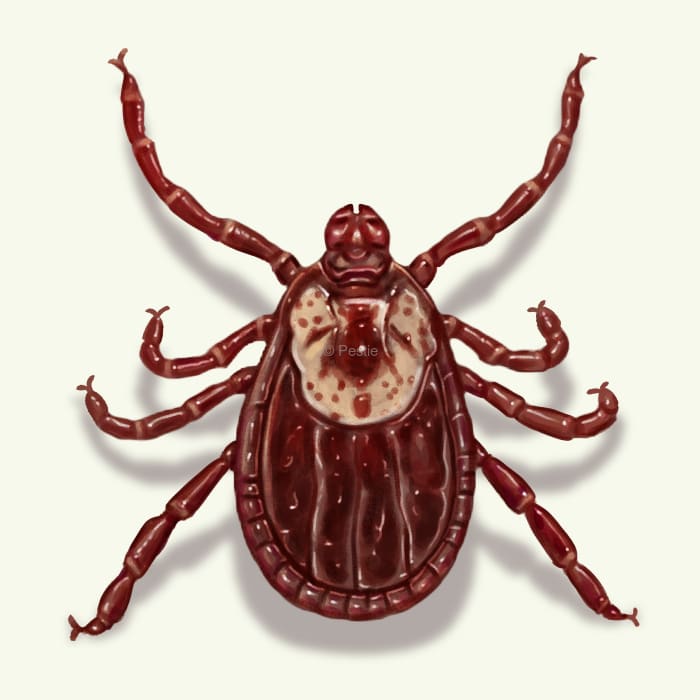How to identify and get rid of American dog ticks

Ticked off: repelling and preventing tick bites
Walking through tall grass isn’t a particularly dangerous activity, but for those in certain parts of the country, you could be heading into a trap…
A small trap, set by the American dog tick.
American dog ticks are small brown ticks that lay in wait on a tall stem of grass, waiting for an unsuspecting host to walk by. They then cling to the host, crawling along until they find a suitable place on the body where they can pierce the skin and start sucking up blood.
It can carry pathogens for several diseases, including being the primary vector for Rocky Mountain Spotted Fever, a fatal disease to humans.
How to identify dog ticks
American dog ticks are just one of the 90+ species of ticks in the US but are easily recognized due to their markings. Each stage of the tick looks a bit different, along with differences between males and females.
Adults are reddish-brown with a hard shield-like structure on top called a scutum. This structure covers only a third of the female top, whereas it covers the entire top of the male. The scutum is also present in the larval and nymphal stages and covers ⅓ of the body.
The scutum has blotchy white markings on it and doesn’t expand as the body fills with blood. Additionally, the female has markings on its top that are reminiscent of a dog’s face, with black dots for eyes and nose.
How big are American dog ticks?
These ticks range between 1/20 inch to 1/6 inch long for adults and only 1/50 inch to 1/15 inch long for larvae and nymphs.
What other ticks look like an American dog tick?
Ticks can be tricky to identify at first sight, and many small tick nymphs and larvae can look alike. The telltale signs of American dog ticks are the mottled white markings on the scutum and the black dots of the dog’s face that give these ticks their name.
Where do dog ticks live?
American dog ticks are found in the eastern half of the United States, ranging from the Atlantic coast to the Great Plains. Additionally, there is a population on the west coast of California.
The nymphs are active in late winter and spring but only feed on small mammals like mice and voles. Adults live in tall grass and are active from spring to summer.
How to get rid of dog ticks
Spraying pesticides in your yard or on your lawn may not always be ideal when trying to control ticks.
**Fortunately, there are several things you can do to prevent you, your pets, and your family from getting bit. **
- Keep your grass cut short
- Place a wood chip or gravel barrier between lawns and sitting areas or play areas
- Clean up areas where rodents can hide
- Prevent wildlife from entering or nesting on your property
If you do have to work or walk in tall grass, you can deter ticks from climbing on you by using tick sprays that include deet in their active ingredients.
Treat dog ticks with Pestie
If you're still having trouble keeping dog ticks away, the best option is to use a pro-grade, effective pest control solution like Pestie.
Pestie is a do-it-yourself pest control solution that's specially designed to keep dog ticks and other pests away from your home.
With Pestie, you can rest easy knowing that your living space is protected and free of creepy crawlies. And the best part? It's designed for people, pets, and the planet, so you can say goodbye to harsh chemicals and hello to peace of mind!
- Save hundreds compared to traditional annual pest plans
- People, pet, and planet-friendly
- Pro-grade customized formulas
Quick facts
How dangerous are Dog Ticks?
Medium danger risk
American dog ticks can carry several pathogens that cause harmful diseases. The major disease of concern is the Rocky Mountain Spotted Fever, caused by the bacteria Rickettsia rickettsii.
These ticks are also known to transmit tularemia and tick paralysis, which can be a problem in dogs and children if the tick is not removed promptly.
- Scientific name
Dermacentor Variabilis
- Other common names
American Dog Ticks, Wood Ticks
- Colors
Adults are reddish-brown with mottled white markings, larvae are grey and brown
- Life span
Abour 14 weeks unfed
- Diet
Larvae and nymphs feed on mice, vole, and other small rodent blood, adults prefer to feed on dogs, but can survive on other medium to large mammals
Females can grow to 5 times their size when they are engorged with blood.








